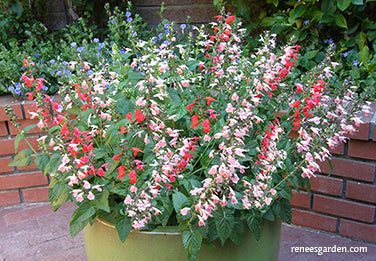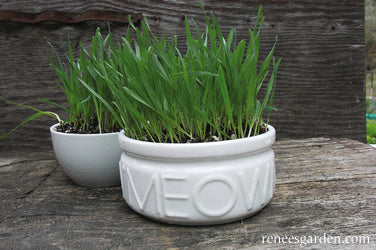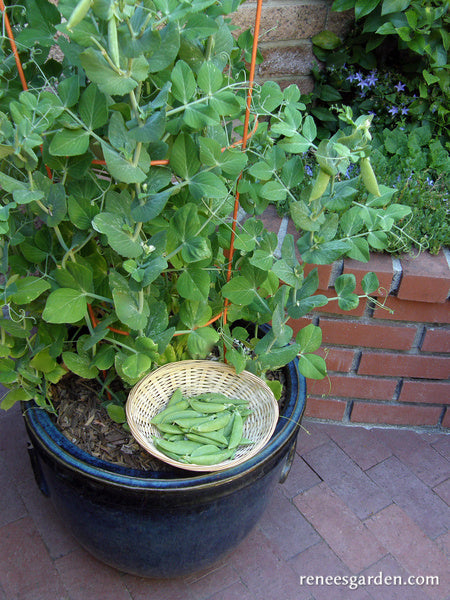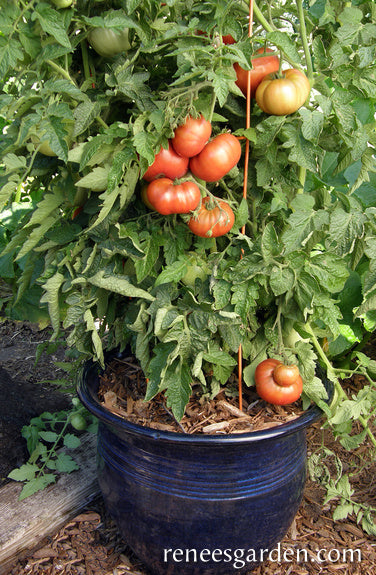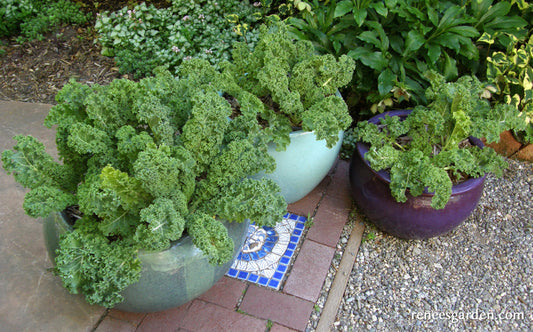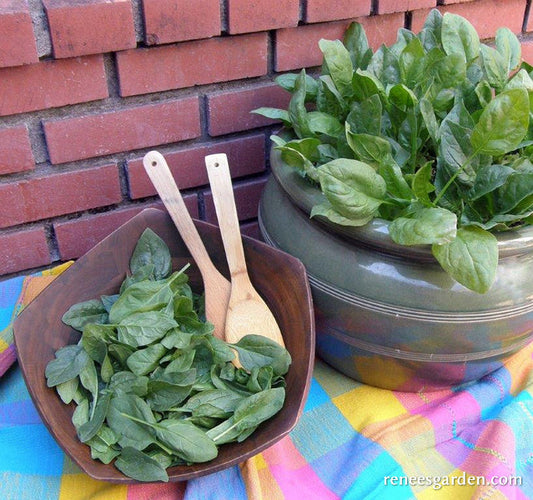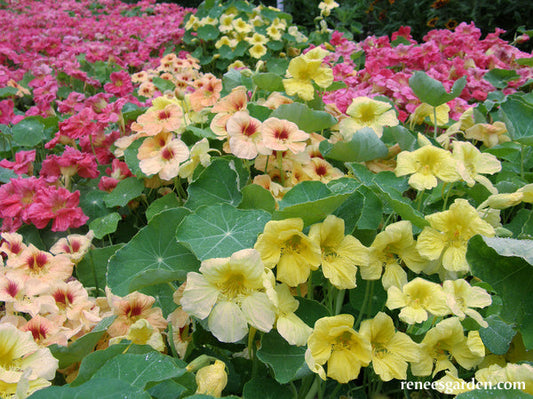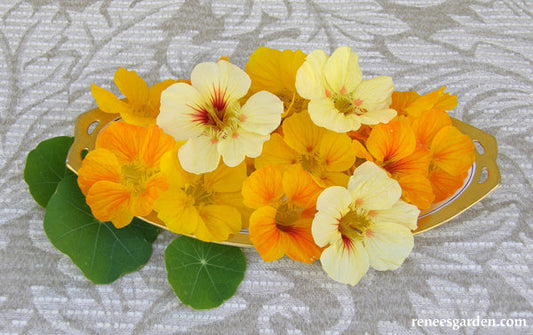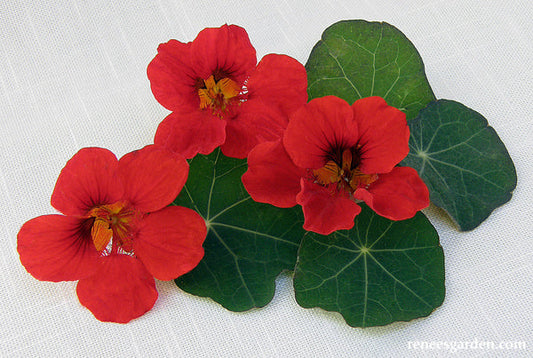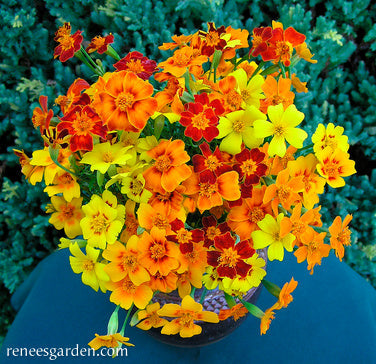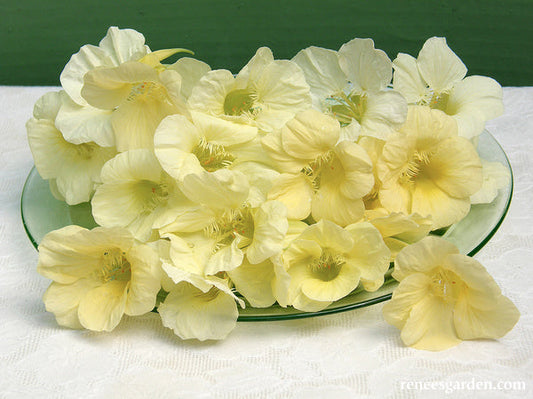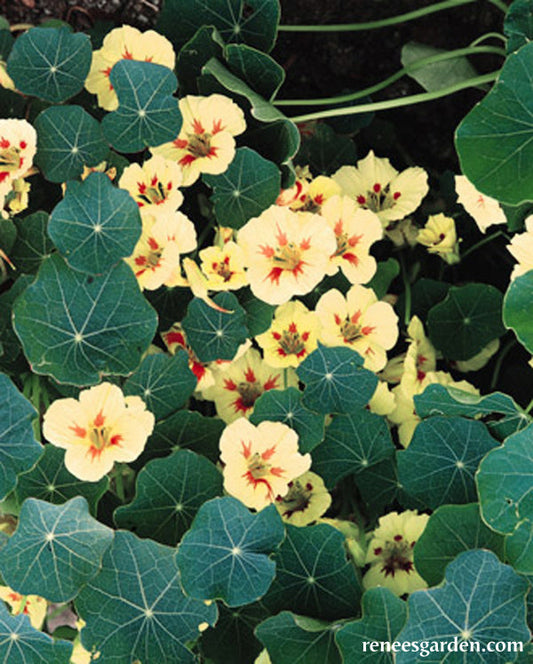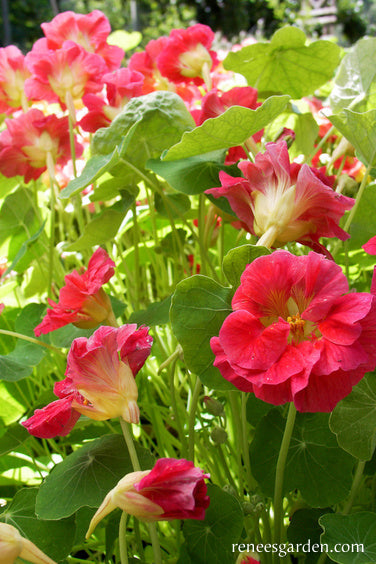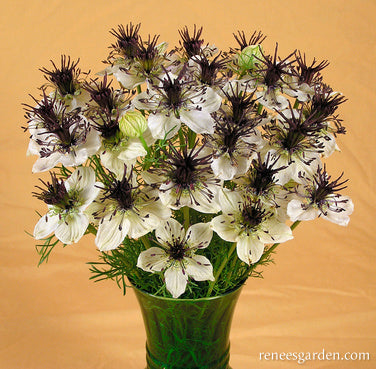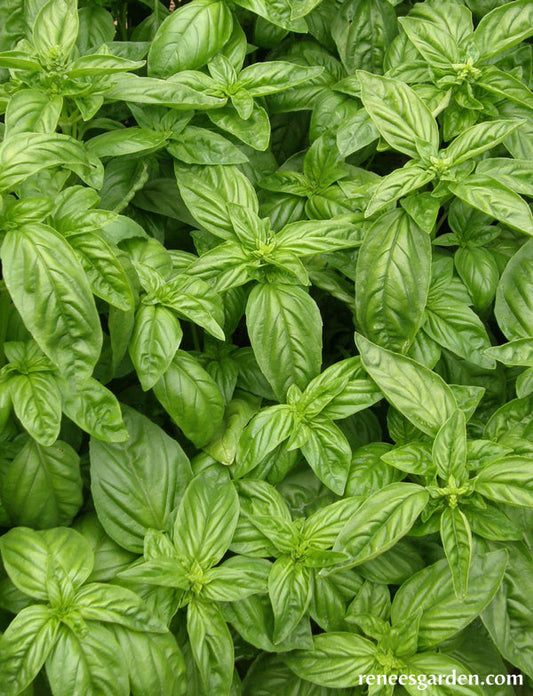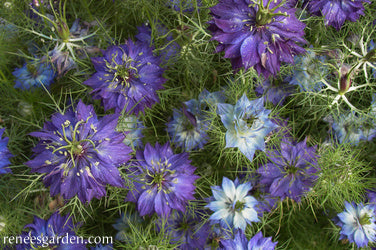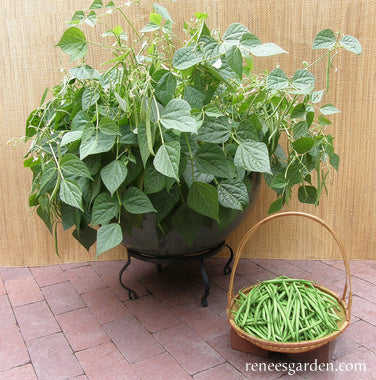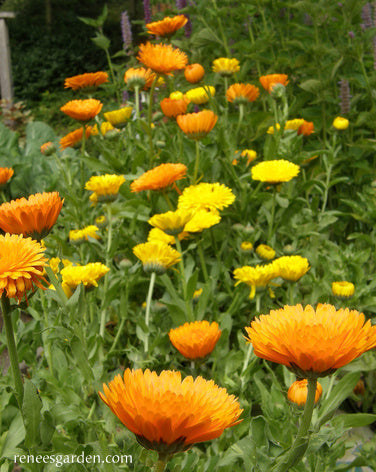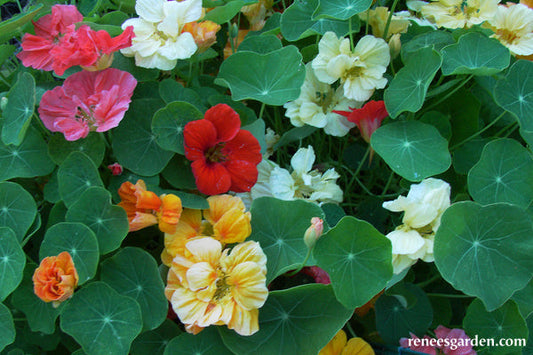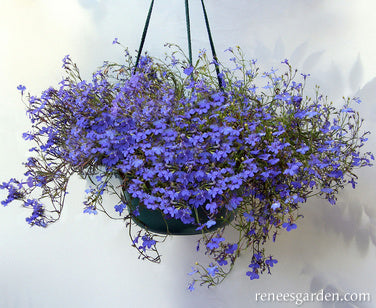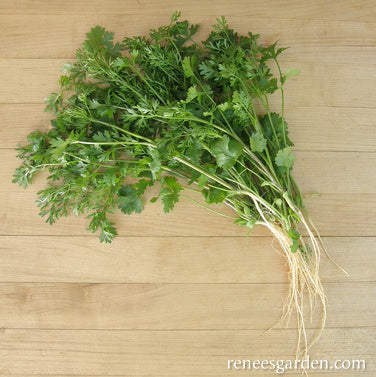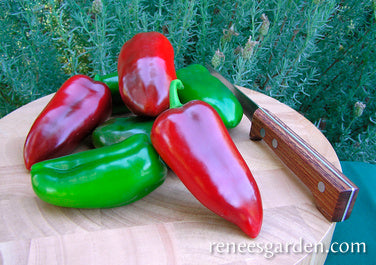Great in Containers
Great In Containers
-
Container/Pollinator Salvia Bee Heaven
TENDER PERENNIAL GROWN AS ANNUAL
Summer/Fall bloom
Frost tenderTO START EARLY INDOORS
Start seeds indoors 4 to 6 weeks before last frost date. Sow seeds 1 inch apart in a container of seed starting mix and cover very lightly. Keep moist but not soggy and provide a strong light source. When seedlings are about 2 to 3 inches tall, and night temperatures are above 50°F (10°C), acclimate to outdoor conditions and plant 8 inches apart.
TO START DIRECTLY OUTDOORS
Sow in well-worked beds or in containers in full sun only after night temperatures reach 50°F (10°C). Plant seeds 4 inches apart and cover very lightly. Keep soil evenly moist. Thin seedlings to 8 inches apart so plants have room to mature.
CONTAINER PLANTING
Plant 4 seedlings in a 20 inch pot; 3 in a 16 inch pot, and 1 seedling in an 8 inch pot.
GROWING NOTES
Plants grow quickly to 12-18 inches tall and bloom all summer long Honey Bees, hummingbirds, butterflies, and many other pollinators constantly visit these nectar-rich flowers.
Regular price $4.69Sale price $4.69Unit price / per -
Bonus Pack Gourmet Greens Cat Treats
FOR BEST RESULTS
Fill a 6 inch diameter or larger pot with moistened planting mix. Sprinkle seeds 1/4 inch apart over the surface, cover 1/2 inch deep with mix, and water gently. Keep pot moist but not soggy, and be sure to provide a good light source. The pot of grasses can be kept indoors for pets to graze on at their leisure. Fertilize every 2 weeks using a non-chemical fertilizer, such as fish emulsion.
GROWING NOTES
This generous packet provides more than enough seed for 10 to 12 sowings for consistent fresh greens. The grasses are ready for pets to nibble when the blades are at least a few inches tall, normally in about 10 to 14 days after sowing.
If grasses get too tall and fall over, "mow" them down to 3-4 inches with a pair of scissors. For a constant supply, try sowing 1 pot a week for 2 weeks. Give your pet access to only one pot of grass at a time, and switch pots each week.
When grass does not re-grow vigorously after cutting down and fertilizing, discard and start again with more seeds and soil mix.
DINING IDEAS
Most cats will recognize the grass as a treat right away. To encourage finicky eaters, place the pot beside the kitty's food and spritz it with water. This usually does the trick and cats who newly discover this treat delight in it!
Regular price $8.99Sale price $8.99Unit price / per -
Container Snap Peas Little Crunch
START SEEDS OUTDOORS
In early to mid-spring, plant peas in full sun in well-worked, fertile soil. Sow 1 in. deep and 3 in. apart. Protect from marauding birds with netting or floating row covers if necessary. Wet, cold early spring weather may affect germination, so if first sowing doesn’t germinate evenly, replant right away: new seedlings catch up quickly. Sow again for a fall crop, several months before fall frosts.
FOR CONTAINERS
Plant in pots at least 15-18 in. in diameter and 12 in. deep. Sow 1 in. apart, 1 in. deep. When seedlings are 2-3 in., thin to 3 in. apart, so each little vine has growing room. Provide 2-3 ft. tall supports or a short trellis at planting time. Mulch to conserve moisture. Feed with all-purpose fertilizer every 2-3 weeks. If it gets hot, check and water containers daily; otherwise, water when the top inch of soil is dry. Water at base of the plants to avoid mildew.
HARVEST AND USE
Harvest only when peas are mature and rounded in the thick-walled, juicy pods for the best developed flavor. Savor their sweet crunch fresh (kids especially love them!) as a snack or slice into salads. To cook quickly, pull strings from pods and sauté in a little oil just until pods turn a deeper green color.
Regular price $4.69Sale price $4.69Unit price / per -
Heirloom Container Tomatoes Tasmanian Chocolate
STARTING SEEDLINGS
In early spring, start indoors about 6 to 8 weeks before outdoor night temperatures are reliably in the 50-55°F (10-13°C). Sow seeds 1/4 inch deep and 1 inch apart in a container of seed starting mix. Keep moist but not soggy, and very warm, 80°F (27°C). Provide a strong light source until seedlings are ready to plant outside. When seedlings are 2 inches tall, transplant into individual 4 inch pots. Maintain at 70°F (21°C). Feed with half-strength fertilizer every 2 weeks until ready to plant. When nights reach 55°F (13°C), gradually acclimate to outdoor conditions. Plant these vigorous, early bearing vines 3 feet apart into rich soil in full sun.
TO GROW IN CONTAINERS
Use pots at least 15-18 inches in diameter and 18 inches tall. Use fresh potting mix to prevent soil borne disease. Transplant one seedling per pot. Water regularly: in hot weather, pots may need daily watering. Fertilize every other week with a low nitrogen fertilizer for strong plants and good yields.
GROWING NOTES
Tomatoes need at least 6 hours of full sun every day. Provide strong stakes or wire cages at planting time as plants get heavy with fruit. Mulch plants well to maintain even moisture. Pick fully ripe. Don’t store tomatoes in the fridge.
Regular price $4.89Sale price $4.89Unit price / per -
Container Kale Green Curls
TO START INDOORS
In very early spring, sow seeds in seed starting mix 2 in. apart and 1/2 in. deep. Keep moist and provide a strong light source until seedlings are well-established, then plant outdoors 6 in. apart.
PLANTING IN CONTAINERS
Use pots a minimum of 15-18 in. in diameter and 12 in. deep and start with fresh potting mix. Sow groups of 2-3 seeds 6 in. apart, 1/2 in. deep. Keep evenly moist. When large enough to handle, thin to leave one seedling per group, so plants have room to mature. Keep mulched to conserve moisture. Feed with high nitrogen fertilizer every 2-3 weeks. If it gets hot, check and water daily; otherwise, water when top inch of soil is dry.
GROWING NOTES
Kale tastes best in cool weather and frost actually enhances color, flavor and sweetness. Plant in early spring and again in late summer/early fall.
HARVEST AND USE
Begin harvesting outer leaves when plants have at least 6 leaves. Vitamin and antioxidant rich kale is tender and delicious in fresh salads, especially with sliced fruit and/or nuts. Use in smoothies, soups, stews and sautés; or braise with garlic and olive oil. Pull and discard when plants begin to bloom as leaves of flowering stalks get tough and bitter.
Regular price $3.99Sale price $3.99Unit price / per -
Container Baby Leaf Spinach Little Hero
CONTAINER PLANTING
Plant in early spring when danger of hard frost is over. Use a pot at least 15-18 in. in diameter and 12 in. deep, and start with fresh potting mix. Sow seeds 2 in. apart or simply broadcast seeds thinly, aiming for 2 in. spacing. Cover with 1/2 inch of potting mix and firm soil well over seeds. If first sowing germinates unevenly, plant more seed as seedlings will catch up fast.
GROWING NOTES
Birds love tender young seedlings, so protect as necessary with netting or floating row cover. Sow again in late summer for a fall crop. Keep spinach well watered and weeded and fertilize every few weeks and especially after harvesting.
HARVEST AND USE
To harvest by the “cut and come again” method: when plants are 4 to 5 in. tall, cut as much as you need, by using scissors to shear off leaves 1 to 2 in. above the soil level. Water well and fertilize lightly and plants will regrow for several more cuttings. Little Hero’s tender, baby leaves are delicious in fresh salads with additions like thinly sliced sweet onions, sliced radishes, thin wedges of apple or orange, toasted nuts, chopped scallions, crispy bacon bits, hard-cooked egg quarters and grated cheese. Or stirfry, braise or sauté very quickly for healthy, tasty greens.
Regular price $3.99Sale price $3.99Unit price / per -
Hummingbird Nasturtiums Aloha Mix
ANNUAL
Spring/Summer/Fall bloom
Frost tenderEASY TO START OUTDOORS
In spring, when danger of frost is past, sow seeds in a sunny spot (or part shade in hot climates). Nasturtiums need no added fertilizer in most soils. Poke seeds into well-worked soil about 1 inch deep and 5 inches apart. Press soil firmly over the seeds and keep moist. When seedlings are large enough to handle, thin to 10 inches apart as mounding plants need ample room to grow.
TO START EARLY INDOORS
Sow 2 seeds each in individual 4 inch pots of well-drained seed starting mix 3 weeks before last expected frost date. Cover 1 inch deep. Provide a strong light source. When seedlings have several sets of leaves, pinch out the weaker seedling, leaving 1 per pot. When weather is evenly in the 50°F (10°C) range, gradually acclimate to outdoor conditions. Transplant seedlings into the garden 10 inches apart in full sun.
GROWING NOTES
These mounding nasturtiums are reliable and easy to tuck into any well-drained spot. They are a perfect disguise to cover fading bulb foliage in late spring. Their softly draping leaves and sunny flowers will quickly fill garden beds or containers. Hummingbirds come readily to drink the blossom’s nectar. Leaves and flowers are tasty additions to salads and sandwiches.
Regular price $3.99Sale price $3.99Unit price / per -
Mounding Nasturtiums Cup of Sun
ANNUAL
Spring/Summer/Fall bloom
Frost tenderEASY TO START OUTDOORS
Sow seeds in spring once all danger of frost is over in full sun (or part shade in hot climates). Nasturtiums need no added fertilizer in most soils. Poke seeds into well-worked soil about 1 inch deep and 3 to 4 inches apart. Press soil firmly over the seeds and keep moist. When seedlings are large enough to handle, thin to 10 inches apart as mounding plants need ample room to grow.
TO START EARLY INDOORS
Sow 2 seeds each in individual 4-inch pots of well-drained seed starting mix 3 weeks before last expected frost date. Cover 1 inch deep. Provide a strong light source. When seedlings have several sets of leaves, pinch out the weaker seedling, leaving 1 per pot. When weather is evenly in the 50°F (10°C) range, gradually acclimate to outdoor conditions. Transplant seedlings into the garden 10 inches apart in full sun.
GROWING NOTES
These mounding nasturtiums are reliable and easy to tuck into any well-drained spot. They are a perfect disguise to cover fading bulb foliage in late spring. Their softly draping leaves and sunny flowers will quickly fill garden beds or containers. In mild winter climates, sow seeds again by mid-June for late summer blooms. Leaves and flowers are tasty additions to salads and sandwiches.
Regular price $3.99Sale price $3.99Unit price / per -
Heirloom Nasturtiums Empress of India
ANNUAL
Spring/summer/fall bloom
Frost tenderEASY TO START OUTDOORS
Sow seeds in spring once all danger of frost is over in full sun (or part shade in hot climates). Nasturtiums need no added fertilizer in most soils. Poke seeds into well-worked soil about 1 inch deep and 3 to 4 inches apart. Press soil firmly over the seeds and keep moist. When seedlings are large enough to handle, thin to 10 inches apart as mounding plants need ample room.
TO START EARLY INDOORS
Sow 2 seeds each in individual 4-inch pots of well-drained seed starting mix 3 weeks before last expected frost date. Cover 1 inch deep. Provide a strong light source. When seedlings have several sets of leaves, pinch out the weaker seedling, leaving 1 per pot. After weather is evenly above 50°F (10°C), gradually acclimate to outdoor conditions. Transplant seedlings into the garden 10 inches apart in full sun.
GROWING NOTES
These mounding nasturtiums are reliable and easy to tuck into any well-drained spot. They are a perfect disguise to cover fading bulb foliage in late spring. Their softly draping leaves and wonderfully colored flowers will quickly fill garden beds or containers. In mild winter climates, sow seeds again in early July for late summer blooms. Leaves and flowers are tasty additions to salads and sandwiches.
Regular price $3.69Sale price $3.69Unit price / per -
Petite Marigolds Heirloom Signet Starfire
ANNUAL
Summer/fall bloom
Frost tenderTO PLANT OUTDOORS
Sow seeds directly into well-worked garden soil in full sun once all danger of frost is past. Space seeds 2 to 3 inches apart and cover about 1/4 inch deep. Keep soil evenly moist while awaiting germination in 5 to 7 days.
TO START EARLY INDOORS
Sow seeds 1 inch apart in a container of well-drained seed starting mix 4 to 6 weeks before last expected frost date. Cover 1/4 inch deep, keep moist and provide a strong light source until ready to go outside. Transplant once weather warms up after gradually acclimating seedlings to outdoor conditions. Thin or transplant 8 to 10 inches apart when seedlings are large
GROWING NOTES
These compact and cheerful antique marigolds are quick to bloom, carefree and non-fussy. Their profusion of dainty blooms and feathery aromatic foliage are perfect for planters in sunny spots, or edging garden beds. Feed and water regularly especially if planting in containers. Consider a second sowing before midsummer for a long season of appealing old-fashioned flowers.
Regular price $2.99Sale price $2.99Unit price / per -
Hummingbird Nasturtiums Creamsicle
ANNUAL
Spring/summer/fall bloom
Frost tenderEASY TO START OUTDOORS
Sow seeds in spring once all danger of frost is over in full sun or part shade in hot climates. Nasturtiums will grow and flower readily with no added fertilizer in most soils. Poke seeds into well-worked soil about 1 inch deep and 3 to 4 inches apart. Press soil firmly over the seeds and keep moist. When seedlings are large enough to handle, thin to 10-12 inches apart so plants will have ample room to grow.
TO START EARLY INDOORS
Sow 2 seeds each in individual 4 inch pots of well-drained seed starting mix 3 weeks before last expected frost date. Cover 1 inch deep. Provide a strong light source. When seedlings have several sets of leaves pinch out the weaker seedling, leaving 1 per pot. When night temps are above 50°F (10°C) gradually acclimate to outdoor conditions. Transplant seedlings into the garden 10 inches apart in full sun.
GROWING NOTES
These mounding nasturtiums are reliable and easy to tuck into any well-drained spot. They are a perfect disguise to cover fading bulb foliage in late spring. Their softly draping leaves and wonderfully colored flowers will quickly fill and gladden garden beds or containers. Both leaves and flowers are tasty, spicy-sweet additions to salads and sandwiches.
Regular price $3.99Sale price $3.99Unit price / per -
Mounding Nasturtiums Buttercream
ANNUAL
Spring/summer/fall bloom
Frost tenderEASY TO START OUTDOORS
Sow seeds in spring once all danger of frost is over in full sun (or part shade in hot climates). Nasturtiums need no added fertilizer in most soils. Poke seeds into well-worked soil about 1 inch deep and 3 to 4 inches apart. Press soil firmly over the seeds and keep moist. When seedlings are large enough to handle, thin to 10 inches apart as mounding plants need ample room to grow.
TO START EARLY INDOORS
Sow 2 seeds each in individual 4-inch pots of well-drained seed starting mix 3 weeks before last expected frost date. Cover 1 inch deep. Provide a strong light source. When seedlings have several sets of leaves pinch out the weaker seedling, leaving 1 per pot. When weather is evenly in the 50°F (10°C) range, gradually acclimate to outdoor conditions. Transplant seedlings into the garden 10 inches apart in full sun.
GROWING NOTES
These mounding nasturtiums are reliable and easy to tuck into any well-drained spot. They are a perfect disguise to cover fading bulb foliage in late spring. Their softly draping leaves and creamy flowers will quickly fill garden beds or containers. In mild winter climates, sow seeds again by mid-June for late summer blooms. Leaves and flowers are tasty additions to salads and sandwiches.
Regular price $3.69Sale price $3.69Unit price / per -
Mounding Nasturtiums Copper Sunset
ANNUAL
Spring/summer/fall bloom
Frost tenderEASY TO START OUTDOORS
Sow seeds in spring once all danger of frost is over in full sun (or part shade in hot climates). Nasturtiums need no added fertilizer in most soils. Poke seeds into well-worked soil about 1 inch deep and 3 to 4 inches apart. Press soil firmly over the seeds and keep moist. When seedlings are large enough to handle, thin to 10 inches apart as mounding plants need ample room.
TO START EARLY INDOORS
Sow 2 seeds each in individual 4 inch pots of well-drained seed starting mix 3 weeks before last expected frost date. Cover 1 inch deep. Provide a strong light source. When seedlings have several sets of leaves pinch out the weaker seedling, leaving one per pot. When night temperatures are above 50°F (10°C), gradually acclimate to outdoor conditions. Transplant seedlings into the garden 10 inches apart in full sun.
GROWING NOTES
These brilliantly colored mounding nasturtiums are reliable and easy to tuck into any well-drained spot. Except in very poor soil, nasturtiums will grow and bloom readily with no added fertilizer. Carefully thinned to proper spacing, they are a perfect disguise to cover fading bulb foliage in late spring and their softly draping leaves and vivid flowers will quickly fill garden beds or containers.
Regular price $3.99Sale price $3.99Unit price / per -
Hummingbird Nasturtiums Vanilla Berry
ANNUAL
Spring/summer/fall bloom
Frost tenderEASY TO START OUTDOORS
Sow seeds in spring once all danger of frost is over in full sun (or part shade in hot climates). Nasturtiums need no added fertilizer in most soils. Poke seeds into well-worked soil about 1 inch deep and 3 to 4 inches apart. Press soil firmly over the seeds and keep moist. When seedlings are large enough to handle, thin to 10 inches apart as mounding plants need ample room.
TO START EARLY INDOORS
Sow 2 seeds each in individual 4-inch pots of well-drained seed starting mix 3 weeks before last expected frost date. Cover 1 inch deep. Provide a strong light source. When seedlings have several sets of leaves pinch out the weaker seedling, leaving 1 per pot. When night temps are above 50°F (10°C) gradually acclimate to outdoor conditions. Transplant seedlings into the garden 10 inches apart in full sun.
GROWING NOTES
These softly colored, intricately marked nasturtiums are reliable and easy to tuck into any well-drained spot. Except in very poor soil, nasturtiums will grow and bloom readily with no added fertilizer. The mounding plants do a fine job of covering bare spots or hiding spent bulb foliage. Use the pretty edible flowers and leaves to add zest to salads and party sandwiches.
Regular price $3.99Sale price $3.99Unit price / per -
Mounding Nasturtiums Cherries Jubilee
ANNUAL
Spring/summer/fall bloom
Frost tenderEASY TO START OUTDOORS
Sow seeds in spring once all danger of frost is over in full sun (or part shade in hot climates). Nasturtiums need no added fertilizer in most soils. Poke seeds into well-worked soil about 1 inch deep and 3 to 4 inches apart. Press soil firmly over the seeds and keep moist. When seedlings are large enough to handle, thin to 10 inches apart so plants will have ample room to grow.
TO START EARLY INDOORS
Sow 2 seeds each in individual 4 inch pots of well-drained seed starting mix 3 weeks before last expected frost date. Cover 1 inch deep. Provide a strong light source. When seedlings have several sets of leaves and night temperatures are above 50°F(10°C), gradually acclimate to outdoor conditions. Transplant seedlings into the garden 10 inches apart.
GROWING NOTES
These mounding nasturtiums are reliable and easy to tuck into any well-drained spot. They are a perfect disguise to cover fading bulb foliage in late spring. Their softly draping leaves and wonderfully colored flowers will quickly fill garden beds or containers. Leaves and flowers are tasty additions to salads and sandwiches.
Regular price $3.69Sale price $3.69Unit price / per -
Heirloom White Nigella Bridal Veil
HARDY ANNUAL
Spring/summer bloom
Can handle light frostEASIEST TO PLANT DIRECTLY IN THE GARDEN
Sow seeds directly into a finely textured, well-drained garden bed as early in spring as the ground can be worked. Space seeds 2 inches apart, in rows 6 inches apart. Cover seed very lightly, about 1/4 inch deep. Or broadcast seeds evenly over the seed bed and cover very lightly. Keep evenly moist while awaiting germination. Thin seedlings to stand 6 inches apart so plants have room to grow and mature. In mild winter climates, Nigella can be sown in early spring and also be sown again in cool fall weather to overwinter for spring bloom.
GROWING NOTES
Make several successive sowings from early spring through early summer and you'll have these carefree specialty flowers blooming all season long. As flowers fade, cut stems of the decorative seedpods. Hang carefully upside down in bundles out of the direct sun to easily dry for everlasting arrangements. Let some seedpods mature and stay on the plants to spill seed and these graceful flowers will come up year after year.
Regular price $3.69Sale price $3.69Unit price / per -
Bolognese Basil Aurelia
ANNUAL
Summer/fall harvest
Heat-loving, frost tenderTO PLANT DIRECTLY INTO THE GARDEN
When late spring weather reaches 55°F (10°C) both day and night, sow seeds 1 inch apart in well worked, fertile soil in full sun. Cover 1/4 inch deep, firm soil and keep seed bed moist. Germination takes 1 to 2 weeks. After seedlings are well established, thin or transplant 8 inches apart, which allows plants enough elbow room grow and mature.
TO START EARLY INDOORS
Sow seeds 1 to 2 inches apart in a container of fresh seed starting mix, 4 weeks before last expected frost. Keep warm and evenly moist, and provide a good light source. Feed with 1/2 strength liquid fertilizer every 10 days. Once weather warms outdoors, acclimate seedlings to outdoor conditions, then transplant 8 inches apart into the garden.
GROWING NOTES
It is critical to sow seed or transplant basil seedlings only when late spring day and nighttime temperatures stay above 55°F (13°C). Harvest sprays of leaves by snipping stems just above two new sprouting lateral branches to encourage lush foliage. Keep flower buds pinched off to extend harvesting. Feed regularly with high nitrogen fertilizer after harvesting to promote new growth. Except in very short season areas, make a second planting three weeks after the first for a continued supply of fresh, aromatic leaves.
Regular price $3.69Sale price $3.69Unit price / per -
Heirloom Love in a Mist Persian Violet Nigella
HARDY ANNUAL
Spring/summer bloom.
Can handle light frostEASIEST TO PLANT DIRECTLY IN THE GARDEN
Sow seeds directly into a finely textured, well-drained garden bed as early in spring as the ground can be worked. In mild climates, sow in cool fall weather for spring bloom. Space seeds 2 to 3 inches apart in rows 6 inches apart and cover 1/4 inch deep. Or broadcast thinly in garden bed and cover 1/4 inch deep. Weed young seedlings carefully and thin to stand 6 inches apart so plants have room to grow and mature.
GROWING NOTES
Make several successive sowings from early spring through early summer and these carefree old-fashioned flowers will bloom all season long. Their delicate blossoms make sweet little bouquets. As flowers fade, cut the decorative seedpods before they mature and split. Hang upside down in bundles out of the direct sun to dry for winter bouquets and arrangements. Let some seedpods mature on the plants to spill seed and these graceful flowers will come up year after year.
Regular price $3.39Sale price $3.39Unit price / per -
Container Bush Beans French Mascotte
START SEEDS OUTDOORS
In spring, once weather is warm and settled and night temperatures stay above 55°F (13°C), plant seeds in well-worked, fertile soil in full sun. Poke seeds in 1 inch deep and 4 inches apart in rows 1½ feet apart.
FOR CONTAINER PLANTING
Sow seeds in big pots at least 18 to 20 inches in diameter and 18 inches tall filled with fresh, moistened, good-quality potting mix. Make additional sowings in more pots several weeks later until the end of June to provide long continued harvests.
GROWING NOTES
Amend soil well before sowing with lots of aged manure or compost. Protect young seedlings from marauding birds by covering with plastic berry baskets at planting time, removing when plants get crowded. Be sure to thin properly—you will have more productive, disease-free plants if seedlings have enough room to mature.
HARVEST AND USE
Pick these fine-flavored French gourmet beans often; at least every other day or while bean pods are young and slender. The more beans you pick, the more the plants will produce. Steam, sauté or roast them quickly just until tender-crisp and serve simply to fully enjoy their tempting flavor.
Regular price $4.99Sale price $4.99Unit price / per -
Butterfly Calendula Mix Orange & Lemon Twist
HARDY ANNUAL
Spring/fall bloom
Takes light frostTO START OUTDOORS
Calendulas bloom best in cool weather, so plant in early spring in well-drained soil after danger of frost is over. Sow seeds 1 in. apart, cover 1/2 in. deep, firm soil and keep seed bed moist while awaiting germination in 7 to 14 days. After seedlings are well established, thin or transplant 8 in. apart.
Container growing: plants also grow and bloom well in pots at least 12 to 16 in. deep and 18 to 20 in. across. Start with fresh potting mix each season, keep well watered and fertilize monthly.
TO START EARLY INDOORS
In early spring, sow seeds 1 in. apart in a container of seed starting mix and cover ½ in. deep. Keep evenly moist as seedlings emerge and provide a good light source until ready to plant outdoors. Transplant when seedlings are about 2 to 3 in. tall after gradually acclimating plants to outdoor conditions.
GROWING NOTES
Thin seedlings to proper spacing for good air circulation and to discourage mildew. Keep faded flowers removed. Lemon & Orange Twist are easy to grow spring annuals, producing sturdy plants soon covered with bright flowers that bloom nonstop and attract butterflies for many weeks. In mild climates: sow again in late summer for winter or early spring flowers.
Regular price $3.39Sale price $3.39Unit price / per -
Rainbow Nasturtiums Whirlybird Mix
ANNUAL
Spring/summer/fall bloom
Frost tenderEASY TO START OUTDOORS
Sow seeds in spring once all danger of frost is over in full sun (or part shade in hot climates). Nasturtiums need no added fertilizer in most soils. Poke seeds into well-worked soil about 1 inch deep and 3 to 4 inches apart. Press soil firmly over the seeds and keep moist. When seedlings are large enough to handle, thin to 10 inches apart as mounding plants need ample room to grow.
TO START EARLY INDOORS
Sow 2 seeds each in individual 4-inch pots of well-drained seed starting mix 3 weeks before last expected frost date. Cover 1 inch deep. Provide a strong light source. When seedlings have several sets of leaves, pinch out the weaker seedling, leaving 1 per pot. When night temps are above 50°F (10°C) gradually acclimate to outdoor conditions. Transplant seedlings into the garden 10 inches apart in full sun.
GROWING NOTES
These mounding nasturtiums are reliable and easy to tuck into any well-drained spot. They are a perfect disguise to cover fading bulb foliage in late spring. Their softly draping leaves and wonderfully colored flowers will quickly fill garden beds or containers. Nasturtium leaves and edible flowers add zest to salads and sandwiches.
Regular price $3.99Sale price $3.99Unit price / per -
Windowbox Lobelia Blue Heaven
ANNUAL
Spring/summer/fall bloom
Frost tenderBEST TO START SEEDS EARLY INDOORS
In early spring, about 6 weeks before last spring frost, sow these tiny seeds thinly in a container of seed starting mix, but do not cover seeds, just press lightly into the soil and gently mist to keep moist until germination. Keep evenly moist and about 65-75°F (18-24°C). Provide a strong light source. When seedlings are large enough to handle and night temps reach 50°F (10°C), gradually acclimate to outdoor conditions. Transplant in little clumps of 4 to 5 seedlings about 5 inches apart in well-drained soil in sun or part shade.
Container Growing: Transplant seedlings into pots or baskets that are at least 10 to 12 inches across and 10 to 12 inches tall. Fill with moistened fresh potting mix, then transplant small clumps of 4 to 5 seedlings several inches apart and water gently. Be sure to keep Lobelia in containers well watered and feed with all-purpose fertilizer every few weeks for continual profuse bloom. Shear spent flowers back for reblooming.
GROWING NOTES
Whether used as a gorgeous groundcover color accent or for a trailing window box or patio container display, this lovely Lobelia will bloom longest if it has rich, moist soil, so don’t forget to water regularly as needed and fertilize frequently.
Regular price $3.39Sale price $3.39Unit price / per -
Vietnamese Heirloom Bac Lieu Cilantro
ANNUAL
Spring/summer/fall harvest
Can handle light frostsEASIEST TO START OUTDOORS
Vietnamese Cilantro doesn’t transplant well; plant seeds directly in the garden. For continuous harvests, start in early spring and make successive sowings every few weeks until summer heat comes on strong. Sow again in cooler fall weather, especially in mild winter areas. Sow seeds in well-drained fertile soil 1 to 2 in. apart in rows 8 in. apart in full sun. Cover 1/4 inch deep and firm soil over seeds. Keep evenly moist as seedlings emerge. Thin seedlings 3 to 4 in. apart before plants get crowded.
GROWING NOTES
Vietnamese cilantro leafs out and flowers quickly as plants mature; lushest, leafy growth is in cooler temperatures of spring and fall. Plants thrive when well watered and thinned early so they have room to grow. If hot weather arrives early, plant in a spot with morning sun and afternoon shade. The lacy flowers of these plants attract beneficial insects and pollinating bees.
HARVEST AND USE
Vietnamese cilantro produces rosettes of leaves low on plants with more finely cut, serrated leaves towards the top. Harvest & use entire plant, including stems, leaves & even young flowers. Traditionally, Vietnamese cilantro is offered on a plate in the center of the table, so diners can help themselves. This delicious edible garnish & flavoring tastes similar to a delicate regular cilantro, but with an additional delicious hint of citrus spice.Regular price $3.69Sale price $3.69Unit price / per -
Container Sweet Pepper Pizza My Heart
STARTING SEEDLINGS
Start indoors 8 weeks before outdoor night temperatures reach 55°F (13°C). Sow seeds 1/4 inch deep and 1 inch apart in a container of seed starting mix. Keep moist but not soggy, and very warm (80°F (27°C). Provide a strong light source until seedlings are ready to plant outside. When seedlings are 2-3 inches tall, transplant into 4 inch pots. Keep at 65-70°F (18-21°C). Feed with half-strength liquid fertilizer every 2 weeks.
When night temperatures reach 55°F (13°C), acclimate seedlings to outdoor conditions. If planting in garden beds, space 2 to 2 1/2 feet apart in rich soil in full sun.
CONTAINER GROWING
Transplant each plant into a pot at least 15 inches tall and deep. Using fresh potting mix prevents soil borne diseases. Fertilize twice per month for best plants and yields.
GROWING NOTES
Peppers need full sun at least 6 hours per day. Mulch well to maintain even moisture. Provide short stakes or cages to support heavy sets of ripening fruit. Check containers often and water regularly; when plants begin setting fruit they may require daily watering.
HARVEST AND USE
Harvest when peppers have ripened to red. Cut rather than pull peppers from plants. Enjoy them sliced up raw, sautéed, stir-fried, grilled or piled on pizza. Discard all pith and seeds to avoid even a hint of heat.
Regular price $3.39Sale price $3.39Unit price / per

